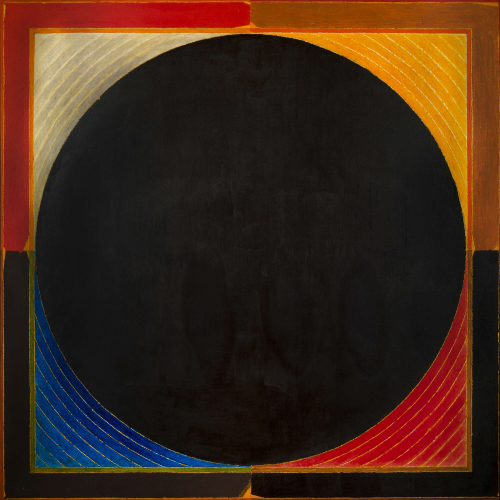Sayed Haider Raza (typically known just as S.H. Raza) was born in Kakkaiya in the Mandla district in 1922. He found a passion for drawing at age 12, going on to study at the Nagpur School of Art between 1939 and 1943, the Sir J.J School of Art between 1943 and 1947, and the Ecole Nationale supérieure des Beaux-Arts between 1950 and 1953.
He was won over by France and he settled in Paris, winning the Prix de la Critique three years after finishing his studies, becoming the first non-French recipient of the award, and was conferred with the Legion of Honour in 2015. The artist was based in Paris for 60 years and would make trips across the country on a regular basis to Brittany and Provence. A retrospective of Raza’s work opened in Paris’ Pompidou Centre on February 15th 2023, running until May 15th. He married the French abstract artist Janine Mongillat in 1959, and only returned to India in 2010 following her death in 2002.
Raza was a highly-awarded artist, having won several honours including the Padma Shri (1981), the Padma Bhushan (2007), and the Padma Vibhushan (2013) – three of the four highest honours available to Indian civilians. He was a visiting lecturer at the University of California during the 1960s (where he was deeply inspired by the work of Mark Rothko, which he referred to as like a “door that opened to another interior vision”) and his Raza Foundation continues to run an annual prize to young Indian artists.

Lot: 196: Syed Haider Raza (1922-2016), Bindu, 1995 Acrylic on canvas, 120 x 120 cm
Raza’s early works were expressionist in style, favouring watercolours and gouache for landscapes made in his 20s during the first half of 1940s. The artist’s childhood experiences of growing up among thick forest – his father was a forest ranger – gave his landscape paintings a deep meditative quality. In 1947 Raza co-founded the Bombay Progressive Artists’ Group (which ran until 1956), with the aim to re-centre Indian modern art around Indian visual traditions, rather than European art history. This coincided with Indian independence from Britain. Raza was one of three co-founders, with K.H. Ara and F.N. Souza, and another major player in the group was Akbar Padamsee. At this time, Raza began to move away from expressionism and towards an abstraction for which he would become recognised. His use of watercolours continued, but he began harnessing non-traditional utensils with which to apply the medium. His journey towards abstraction continued in France, as did his dedication to landscapes.
During the 1970s Raza found a fondness for thick impasto application of paint (now using oil rather than watercolour or gouache), and visits to India in this decade inspired a second coming of his style as an artist, reinforcing the importance of Indian iconography for his practice. Geometric elements dominated his artwork, inspired by the concept of the circular ‘Bindu’ – an energy centre-point for creation. Raza referred to this symbol as “the seed, bearing the potential of all life”. At this point the artist ceased to paint recognisable landscapes altogether and his focus lay entirely on abstraction and the Bindu. Other Indian spiritual concepts included in Raza’s work were that of ‘Purush’ and ‘Prakriti’, male and female complementary forces which he embodied in triangular motifs. In 2000 the artist’s work began to explore sacred Indian spiritual practices.
S.H. Raza passed away in 2016 aged 94, having worked every day up until his death. His work continues to have a keen collector base, and in 2018 it reached its record price at auction, with Tapovan (1972) selling for over $4.5 million at Christie’s in New York. The Centre Pompidou retrospective presents almost 100 works by S.H. Raza, and Roseberys are thrilled to present an acrylic on canvas work by the artist in the upcoming Antiques, Islamic, and Indian Arts sale on April 28th. The 120 x 120 cm canvas made in 1995 will appear in Vol III of the Catalogue Raisonne of the painter's work, collated by Anne Macklin on behalf of the Raza Foundation, New Delhi. Lot 196 has a £50,000 to £70,000 (plus buyer’s premium and VAT) estimate and is sure to garner attention from collectors around the world with an interest in the development of modern abstraction.
